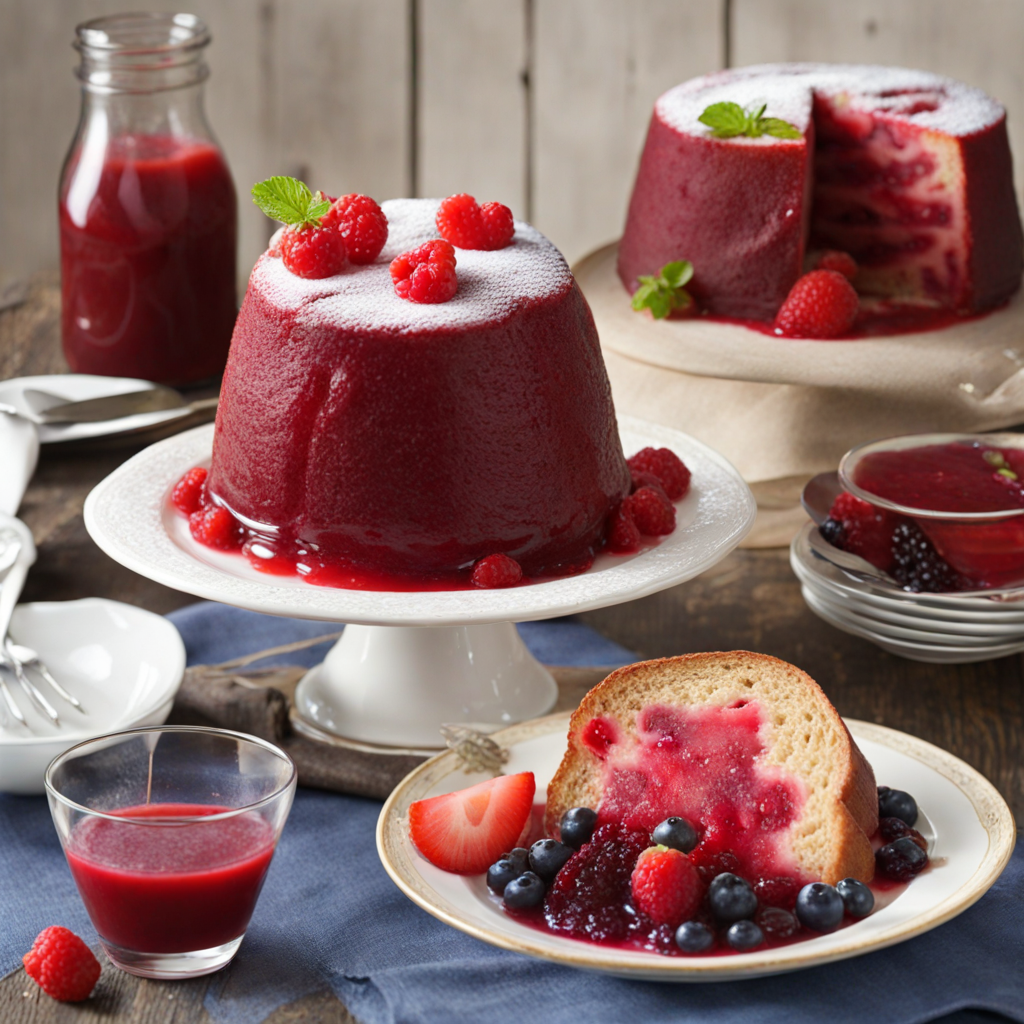Summer Pudding
Summer Pudding is a quintessential British dessert that embodies the essence of summer through its vibrant colors and fresh flavors. This delightful dish typically features a medley of seasonal berries, such as raspberries, strawberries, blackberries, and redcurrants, which are layered between slices of bread. The bread, traditionally white, is used to encase the juicy fruit, soaking up the sweet and tangy juices that are released during the maceration process. The combination of the tart berries and the soft, spongy texture of the bread creates a unique mouthfeel that is both refreshing and indulgent. The preparation of Summer Pudding is relatively simple, making it an accessible treat for home cooks. The berries are gently cooked with sugar until they release their juices, creating a luscious syrup that is poured over the layered bread. Once assembled, the pudding is pressed down, allowing the flavors to meld together, and then chilled in the refrigerator for several hours, or preferably overnight. This resting period not only helps the bread absorb the berry juices but also enhances the overall flavor profile, making each slice a delightful burst of fruity goodness. When served, Summer Pudding is often garnished with a dollop of clotted cream or a scoop of vanilla ice cream, which adds a creamy richness that beautifully balances the tartness of the berries. The visual appeal of this dessert is undeniable, with its deep crimson hues inviting you to take a bite. Each forkful is a celebration of summer, offering a taste of the season's best fruits, and is perfect for picnics, barbecues, or any gathering where a light and satisfying dessert is desired.
How It Became This Dish
The History of Summer Pudding: A British Delight Origins and Early Beginnings Summer pudding is a quintessential British dish that encapsulates the essence of summer while utilizing the bounty of seasonal fruits. Its origins can be traced back to the late 19th century, with the first documented mentions appearing in various British cookbooks from the early 1900s. The dish is believed to have emerged from the traditional practice of using leftover bread and surplus summer fruits, particularly berries like raspberries, blackberries, and redcurrants. The prevailing theory is that summer pudding was created as a way to make the most of the abundant fruits available during the warmer months. Bread, often stale, was repurposed to absorb the juices from the fruits, creating a deliciously sweet and tangy dessert that showcased the flavors of summer. This practice of utilizing leftover ingredients is a hallmark of British culinary history, indicative of a culture that values thrift and resourcefulness in the kitchen. Cultural Significance Summer pudding holds a special place in British culture, symbolizing the joy of the warmer months and the celebration of seasonal produce. It is often associated with picnics and family gatherings, where the dish is served as a refreshing end to a meal. The vibrant colors of the berries, combined with the simple yet elegant presentation, make it a visually appealing centerpiece for summer feasts. The dish is also emblematic of the British affinity for puddings, which have been a staple of the national diet for centuries. From suet puddings to bread and butter pudding, these sweet dishes are deeply rooted in British culinary traditions. Summer pudding, with its lightness and fruitiness, offers a counterpoint to the heavier desserts typically enjoyed in colder months, reflecting the seasonal shifts in both climate and cuisine. As British society evolved, so too did the culinary landscape. The post-war era saw a renewed interest in home cooking and traditional recipes, with summer pudding enjoying a revival. Cookbooks from the 1960s and 1970s featured the dish prominently, encouraging a new generation to appreciate its simplicity and the use of fresh ingredients. Development Over Time Although summer pudding has remained largely unchanged in its core ingredients and method, variations have emerged over the years. The traditional recipe calls for a medley of summer berries, often including raspberries, strawberries, blackcurrants, and redcurrants. The bread used is typically white, although some modern interpretations incorporate brioche or wholemeal bread for added flavor and texture. The technique for making summer pudding has also evolved. Traditionally, the bread is lined in a bowl, filled with the mixed berries, and then covered with more bread to create a sealed pudding. The assembled pudding is then weighted down and refrigerated for several hours, allowing the bread to absorb the fruit juices and take on a beautiful, rich color. The result is a striking dessert that can be sliced and served cold, often accompanied by clotted cream or custard. In recent years, there has been a resurgence of interest in foraging and using wild ingredients, leading to a more adventurous approach to summer pudding. Chefs and home cooks alike have begun experimenting with different fruits, including more exotic options like peaches, cherries, and even edible flowers. This modern twist on a classic dish reflects a broader trend in the culinary world towards creativity and experimentation, while still honoring the dish’s rustic roots. Summer Pudding in Contemporary Cuisine Today, summer pudding is celebrated not only in homes across the UK but also in restaurants and cafes that pride themselves on seasonal menus. It appears frequently in summer specials, often highlighting locally sourced ingredients. The dish has become a symbol of the farm-to-table movement, as more people seek to connect with the land and the seasons through their food choices. The popularity of summer pudding can also be attributed to the growing interest in sustainable cooking practices. As awareness of food waste and environmental impact increases, dishes that utilize every part of an ingredient, like summer pudding, resonate with consumers who wish to make mindful choices. The pudding serves as a reminder of the importance of savoring seasonal produce, encouraging a deeper appreciation for the flavors and textures of the natural world. In popular culture, summer pudding has made appearances in literature and media, further solidifying its status as a beloved British classic. Its use in novels and films often evokes nostalgia, transporting audiences to sun-drenched picnics and carefree summer days. This connection to memory and place adds an emotional layer to the dish, making it not just a recipe but a cultural artifact that tells a story of community, family, and the joys of seasonal eating. Conclusion Summer pudding is more than just a dessert; it is a celebration of summer, a testament to British culinary tradition, and a reflection of evolving food culture. Its origins rooted in thrift and resourcefulness, this dish has evolved over time to embrace modern culinary innovations while remaining true to its simple, rustic charm. As it continues to grace tables across the UK and beyond, summer pudding reminds us of the beauty of seasonal ingredients and the joy of sharing good food with loved ones. Whether enjoyed at a picnic, a family gathering, or a quiet evening at home, summer pudding is a delicious embodiment of summer’s sweet bounty, cherished by generations and sure to delight for many more to come.
You may like
Discover local flavors from United Kingdom







